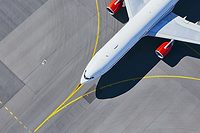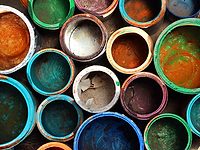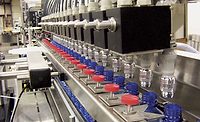How Is Automation Changing the Paint and Coatings Industry?

Automation has brought drastic improvements to numerous sectors - industrial painting among them. Perhaps you’re interested in automating some parts of your paint booth, or maybe you want an advanced robot to handle every aspect of a certain step in the coating process.
Investing in automation alone is not enough to guarantee optimal results. You must also select the right robotic painting systems for the job. For example, non-synchronous methods are not as efficient as synchronous ones, but they typically offer more flexibility due to their compartmentalized designs. Also, single-station booths are affordable solutions, but they have a lower capacity than most synchronous machines, which are constantly in motion.
Understanding what you want to achieve with automation is crucial for any painting or coating task. Here’s a look at some of the gains that automation provides to professionals in this industry.
Allowing More Consistent Results
Even the most meticulous people cannot offer error-free performance. However, robotic painting systems can provide the kind of reliability that painting and coating companies need. Often, such technology is essential for helping overcome known challenges.
Such was the case with German company WB Coatings. It developed a paint system that gives a chrome-like finish to surfaces such as decorative interior vehicle trim after applying one to three layers. The product requires a thin, even coating that is too precise for even experienced humans to achieve.
The company invested in a six-axis robot that can paint 3D materials with complex shapes. Since the machine comes pre-installed with software, it was set up and ready to go in a day and a half. Plus, the robot’s compact design lets it fit into an existing paint booth. A person would even have enough room to stand beside a nonoperational machine to complete manual tasks.
Automation can improve overall quality by removing human error. That’s particularly advantageous in manufacturing facilities where labor shortages exist. When employees must consistently work fast because a company does not have a large enough workforce, accidents and mistakes are more likely to happen.
Mimicking Human Actions
Before some decision makers invest in automation, they worry that the machines will not successfully match the movements humans do when engaging in specific processes. However, various training methods exist, and some allow people to directly demonstrate how a machine should move.
For example, one emerging kind of learning is called self-learning programming. It accounts for the reality that a computer programmer could not compensate for the years of experience a professional painter or coating specialist possesses. This approach allows a person to disengage a robot’s mechanisms, making its attachments weightless.
The painter then attaches a control handle to the machine. It lets them show the robot how to apply liquid or powder and use a blowoff or suction gun. The robot receives the training in real-time, allowing the machine to match the painter’s movements.
Self-learning programming is one of the fastest, most reliable methods of teaching a robot. That’s because it depends on a person’s existing expertise. Some machines even accept input without individuals stopping a production line or conveyor belt to teach them.
Increasing Efficiency
Robotic technology can also raise overall efficiency rates in industrial painting without sacrificing quality. One recent example is an automated painting and finishing machine built by an Italian company that can accommodate two spray guns on a robotic arm. That setup doubles the coverage rate a human could achieve.
That system can also apply paint or coating to any component less than 6 inches tall. Alternatively, the machine can spray adhesive on medium-density-fiberboard cabinet doors, preparing them for membrane presses. It features a 3D vision scanner that sends details about a part to a robot inside the spray booth.
A dual shuttle table also moves components in front of the machine, ensuring the best placement for appropriate coverage. That part holds much larger pieces, accepting those up to 52 inches wide and 10 feet long.
Regardless of the type of robotic painting equipment you have, proper upkeep will boost the return on investment. Without a preventive maintenance plan, you’re likely negatively impacting efficiency and may spend too much on operating costs. For example, routine maintenance appointments can identify issues you didn’t notice were raising your energy bills. They can also pinpoint problems that would cause unexpected breakdowns if left unaddressed.
Meeting Industry-Specific Needs
Automation is also ideal for addressing requirements that people in specific industries face. For example, automotive companies choose paints that withstand pollution and frequent sun exposure.
In the pharmaceutical sector, syringes need silicone coatings. They’re vital for prefillable needles and provide lubrication that lets the plunger glide through it. Moreover, silicone-coated glass prevents a drug’s ingredients from getting absorbed into the syringe’s material by creating a barrier.
One pharmaceutical company deployed a set of four robots to assist with its syringe-coating needs. That approach allowed a coating rate of 38 syringes per minute. These machines also meet cleanroom standards, making them suitable for the stringent requirements of pharmaceutical companies or other organizations that must safeguard against contaminants.
The pharmaceutical business and the technology partner that developed this coating solution began with a concept phase in 2018. By November 2020, the client had a fully functional machine, making it well-equipped to deal with the increased syringe demand associated with COVID-19 vaccination rollouts.
If you’re thinking about investing in a customized solution, keep in mind that it’ll take longer to develop than a ready-made option. However, custom products could be the best to go with if your industry has exceptionally precise requirements.
Supporting Sustainability Goals
Automation can also help painting and coating companies adhere to sustainable practices. Part of a business’s framework for responsible operations may include looking at ways to reduce waste. Robotic painting technology can help achieve that aim.
A Chinese automotive factory that produces vehicles from brands like Volkswagen and Skoda had 300 painting robots installed to assist with its ongoing sustainability efforts. Instead of using a water-circulation approach to paint, the machines use a dry spray absorption method. It circulates air and absorbs the spray with limestone.
Since this method reuses up to 95% of the air and allows limestone recycling, energy savings of up to 60% can occur. Moreover, the factory utilizes primer-free painting technology. It can reportedly raise paint utilization rates and minimize waste.
If you’re considering robotic painting systems to enhance sustainability outcomes, first identify the areas with the most opportunities for improvement. Then, investigate how automation might directly address those issues. Alternatively, approach a robotics company representative with your expectations and requirements. Find out which machines are best suited to meet them.
Automation Facilitates Industrial Painting Success
This overview highlights some of the most common advantages that automation can bring to painting and coating professionals. Tracking metrics before and after implementing such technology makes it easier to see how things change over time.
Looking for a reprint of this article?
From high-res PDFs to custom plaques, order your copy today!








